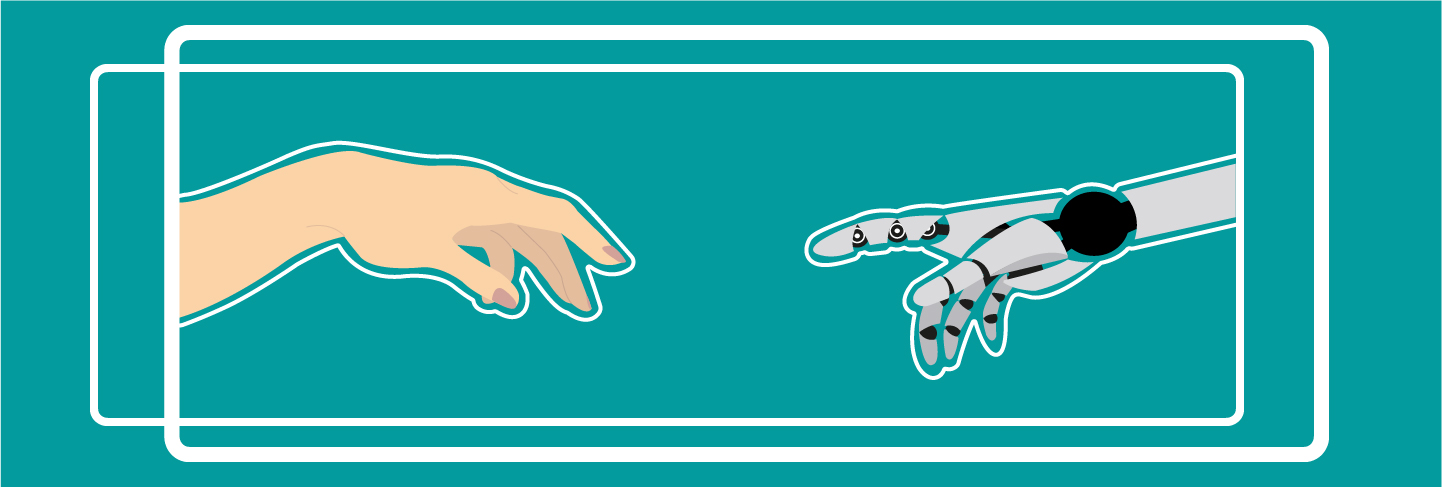The interactions between humans and machines, such as mobile robots, are constantly increasing due to the advancing degree of automation in production and logistics processes. In addition to the challenges created by these interactions, we as the Department of Robotics and Cognitive Systems see these challenges as opportunities to identify new synergy effects in flexibilized workflows between humans and machines and to use them through technical solutions in production and logistics. In addition to reducing health risks, such as stress and posture problems, and increasing the acceptance of technical innovations, the use of human-machine interaction (MTI) methods has the potential to increase the productivity of work processes.
For example, to orchestrate the interaction between humans and machines, digital twins of humans and machines can be created. These digital twins offer the possibility that the behavior of humans and machines, for both interacting parties, becomes comprehensible and in part predictable.
In order to validate our MTI solutions, the Robotics and Cognitive Systems department conducts subject studies as well as qualitative and quantitative analyses.
Augmented Reality
The proper involvement of employees is an essential feature of efficient processes. Despite automation, we continue to focus on collaboration between people and technology. By means of a wide variety of interfaces, we enable simple interaction. Complex systems can be easily controlled via augmented reality and the required information is displayed directly in the employee's field of vision. The use of additional sensor technology and 3D image processing strengthens process reliability.
Augmented reality is used in a wide variety of logistics processes, such as goods receiving, picking or packaging. For example, the picker receives specific product information during the picking process via special data glasses. In addition, coordinates of the product location and the quantity to be picked are visually displayed. Fraunhofer IML has been conducting research in the field of augmented reality for many years and has, for example, developed a system that improves packaging processes with the help of data glasses. Here, the employee is guided through the process and shown where the product should be optimally placed.
AR - Tailored solutions
The use of AR technologies is not limited to the classic AR glasses, but works just as well with a smartphone or tablet. Depending on the respective application area, there are thus different possibilities based on different platforms and mobile devices to make use of augmented reality and benefit from the technology. On this basis, Fraunhofer IML develops flexible and individual solutions for logistics processes.
AR - enhancing usability
Augmented Reality supports people in a wide range of activities and enables safe as well as easy handling - for example with automated guided vehicles or cyber-physical systems in general. Through the technology, employees receive important background information about the current location of the machines and are alerted about approaching vehicles. In addition, they are shown the correct route through the warehouse to the respective products without colliding with the vehicles. But augmented reality also enables simplified handling in the area of maintenance and repair. For example, maintenance plans as well as additional design data can be projected into the worker's field of vision.
AR - Visual - Individual
Augmented Reality can be used in different ways, depending on the respective application, which means that the use of the three-dimensional representation of objects is not always necessary. For maintenance work or repairs, for example, it is sufficient for simple texts or information about the respective machines to be projected into the worker's field of vision.
The right data glasses
In binocular AR glasses, which resemble the basic design of ordinary glasses with two lenses, the visible area of reality is either overlaid with virtual content or completely blended. In addition to binocular AR glasses, there are also monocular data glasses. Unlike binocular AR glasses, these glasses are designed to be used on one eye, making them more comfortable. Which solution to consider for which area always depends on the specific use case.
Social robotics
The field of social robotics is also a focus of the Robotics and Cognitive Systems department. The ergonomic, mobile, interactive load carrier for intralogistics (EMILI) represents an example of a complex, social robot. As a mobile robot, EMILI is capable of interacting with humans in a variety of ways and performing tasks in intralogistics application scenarios.
Multimodal interaction
Intelligent objects and modern, self-controlling processes are increasingly coming into focus due to the topic of "Industry 4.0". For process control and the coordination of distributed systems, information is required that must be determined on the one hand and made available to the operator of production and logistics systems on the other. Several challenges arise here, which Fraunhofer IML helps to overcome. These range from information acquisition directly at the machine to information processing in the system to information presentation for humans.
Before data can be adequately presented to humans, the corresponding information must be determined. This is done, for example, with so-called smart devices. These are technical components that record the necessary operating data from the various machines and systems in a standardized manner, process it and forward it to a platform. There, the subsequent processing of the data takes place, which prepares all incoming information for display, taking into account various factors. Among other things, the role, location and task of the respective employee for whom the information is to be prepared are taken into account. Depending on these parameters, the depth and direction of the information changes. For example, an employee on the assembly line in quality assurance requires completely different information than an employee in production or an order picker in logistics. The type of data to be displayed on the wearable and the level of detail permitted by the corresponding end device are also decisive here.
 Fraunhofer Institute for Material Flow and Logistics IML
Fraunhofer Institute for Material Flow and Logistics IML